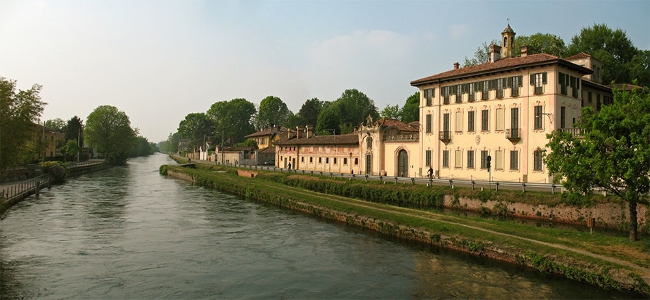 Starting from Milan you can go along the Big Naviglio, by bicycle, motorcycle or car: the route, very easy and well marked by road signs, forecasts a total of about 20 km from Gaggiano to Robecco sul Naviglio.
Starting from Milan you can go along the Big Naviglio, by bicycle, motorcycle or car: the route, very easy and well marked by road signs, forecasts a total of about 20 km from Gaggiano to Robecco sul Naviglio.
Start from the Gaggiano centre: there you will find Venini Uboldi Palace and the baroque Marino Villa who is said to have been a resort place of the banker Thomas Marino. From the town center you can take the route of ancient monasteries, or continue along the State Road 494 towards Abbiategrasso: you will arrive in Castelletto, a small picturesque village at the point where the Naviglio splits: here you can see the great Cittadini Palace, where Giuseppe Mazzini stayed with rich eighteenth-century frescoes inside.
Leaving from Castelletto towards Abbiategrasso you will arrive in Mazzini Street: along the road there is Corio Palace, once seat of Duty and just beyond the impressive Sala Cocini Villa, of the eighteenth-century. In the centre of Abbiategrasso go to Teotti Street, where raises the facade of Orsini House of Rome, which has kept Medieval and Renaissance forms. Then move into Cattaneo Street to visit the Civic Sanchioli Villa, recently restored, with a large surrounding park and structures dating back to the eighteenth and nineteenth century.
Leaving Abbiategrasso make a stop in Cassinetta di Lugagnano: the eighteenth-century Negri Palace is the Town Hall seat, but do not stop only there because the village is rich in beautiful luxury buildings: Visconti Villa, neoclassical, Eusebio Villa of the eighteenth-century, Trivulzio Villa, example of a Piermarini's refined neoclassicism and finally Clari Monzini Villa, of the beginning of the eighteenth century.
You can always finish your route along the Big Naviglio in Robecco: another place rich in nobiliary buildings, among which the most spectacular is certainly Archinto Villa by the Abbiategrasso architect Carlo Federico Pietrasanta, incomplete but fascinating in the facing of its crenellated towers on the canal water; next you will find Gandini Villa, once amusement court of Ludovico il Moro, which already existed in the fourteenth century, changed in the next. On the other side of the Naviglio there is Sironi Marelli House, with rich gardens, while more inside the village are located Gromo Villa of Ternengo, of the seventeenth century, and Scotti Villa, the Town Hall, of the beginning of the nineteenth century.
(In the photo: the center of Cassinetta di Lugagnano - Photo by Domenico Iacaruso)
 English (UK)
English (UK)  Italiano (Italia)
Italiano (Italia) 